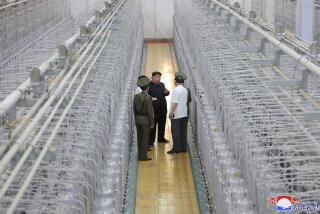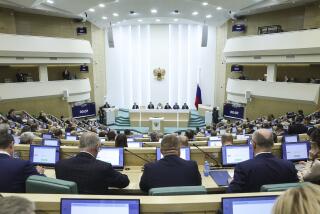May Set Precedent on Verification : Soviets Open Nuclear Test Facility to U.S. Scientists
- Share via
MOSCOW — The Soviet Union has opened its chief nuclear test site for the first time to U.S. scientists for an inspection tour that may set a precedent in arms control verification, the head of the U.S. group said Friday.
Robert B. Barker, who leads the U.S. delegation to superpower talks in Geneva on nuclear testing, returned to Moscow with other members of the 20-member group after a five-day tour of the Semipalatinsk test range in Soviet Kazakhstan.
He told reporters the Soviets fully met obligations reached at the U.S.-Soviet summit last month, when the superpowers agreed to allow visits by the other side to their nuclear test sites.
Under the accord, Soviet inspectors are to visit the U.S. test range in Nevada on Jan. 25-30. The visits may open the door to Senate ratification of two 1970s test treaties and possible negotiations to end all tests.
At Geneva, the superpowers have been discussing whether new techniques to measure the yield on nuclear explosion can improve the verification of the two treaties.
New CORRTEX System
Under the agreement, U.S. scientists are to return later this year to Semipalatinsk, about 2,000 miles southeast of Moscow, to measure the yield of a Soviet nuclear test explosion with a new system known as CORRTEX.
“We want to show them that CORRTEX does everything we say it does,” Barker said.
CORRTEX stands for Continuous Reflectometry for Radius Versus Time Experiment, and measures electrical signals from a cable sunk 30 feet from the hole where the nuclear blast occurs.
The Soviets, and many government and private specialists in the United States, say seismological equipment, such as that used to measure earthquakes, is adequate enough to verify that the treaties are being observed.
The two sides hope the visits will lead to joint verification experiments, tentatively scheduled for April, to test CORRTEX at Semipalatinsk and allow the Soviets to use their instruments to measure an underground explosion in Nevada.
“As soon as we conduct the experiments and evaluate data, we can decide then whether further tests are necessary or we can agree on improved verification measures,” Barker told a news conference.
He hailed the agreement on the exchange visits and experiments as a precedent in disarmament negotiations.
“It’s a very good model for future arms control measures when two nations can have technical experts sit down together and decide on verification measures,” he said.
Barker said the Soviets “fully complied” at Semipalatinsk with the agreement on providing information about testing and measuring test yields, but declined to provide specifics, saying they were confidential.
A joint U.S.-Soviet statement on the visit said the Americans saw the Soviet procedure for staging nuclear blasts and instruments used to measure their yield, and toured laboratories and living quarters at the range.
More to Read
Sign up for Essential California
The most important California stories and recommendations in your inbox every morning.
You may occasionally receive promotional content from the Los Angeles Times.













